
Sailing Vessel Beruta Ship's Log
Huahine, French Polynesia - Aitutaki - Palmerston, Cook Islands
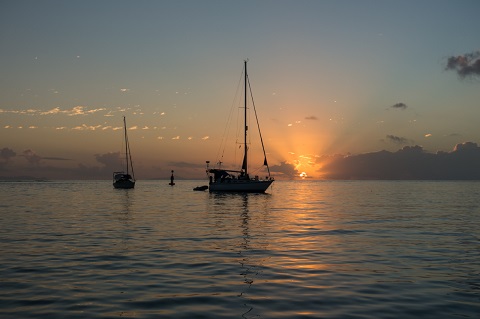
3 August 2016
I left Fare two days later than I had planned, mostly because of the weather. There was no wind for August 2. Instead of rolling at sea, I decided to use this time at the calm anchorage and do some useful things like dinghy and mainsail repairs, cockpit cleaning, etc.
I left at 16:00 local time (UTC-10) just as the onshore SW wind blew from the coming black clouds. I raised the half main while motoring through the passage. For a little while the wind change to the south. I put the jib and enjoyed pure sailing heading towards the south point of Raiatea. Then I had to switch to motorsailing again as the wind was 30° on the portside, too close hauled to pass the reef under the sails.
After 5 and half hours I left behind the last island of French Polynesia on my way across the Pacific ocean, spotted some lights from distant Bora Bora, stopped the engine and took 240° M course to Aitutaki. The route length is about 520 nm. I intended to arrive to Cook Islands in 5 nights on Monday, August 8.
After dark the wind increased to 20 kts. Reaching under half main and jib was too fast. Therefore, I pull down the main and was sailing 4.5 - 5 kts just under the foresail.

4 August 2016
The 20-kt south wind continued in the morning gradually becoming south-east; hence, the apparent wind decreased to 15 and I hoisted the half of the mainsail. The speed became 5-6 kts.
For the last 24 hours Beruta sailed  117 nm.
117 nm.
At night the wind blew at 150° on the portside, meaning that either the mainsail or the jib had to go down. I chose the jib this time.
5 August 2016
Yesterday I checked the tide info for Aitutaki in the chartplotter. The high water would be at 8:00 Tahiti time and then at 20:00. The passage to the lagoon there is long and shallow in one place. At the lowest low water it would be 1.4 m only, just the same as Beruta's draft. The tide table said that at low water it was +0.3m and at high +0.6m. I might be ok even at the low water but the outflow current could be strong and people recommended to enter the lagoon close to the high water or at least with the tide. The problem would be the visibility. I seem to arrive early in the morning meaning that I would have to go against the sun through the channel. I guessed the best time to enter would be afternoon, maybe three hours after the low water. It might be possible to anchor outside the lagoon and wait for the right moment.
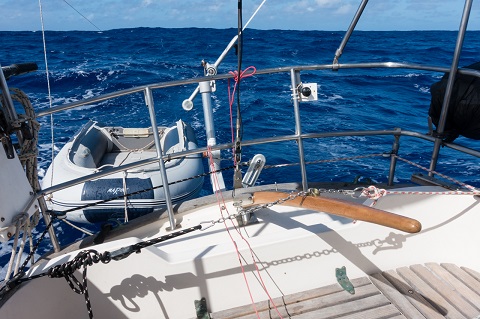
In the morning the wind became light, around 10 kts and boat speed 3.5. I took off the reefs on the main. The speed became 4.5.
After loosing a few games to Fritz today, I determined to do something useful and fix windpilot steering lines. When I installed the outboard davit in Nuku Hiva, the tube was the right place for the steering line block on the starboard. On the portside I had the tube, on which the wind generator located. It turned out to be not in the correct position and the line was tearing off the pushpit stanchion. I found a short piece of tubing and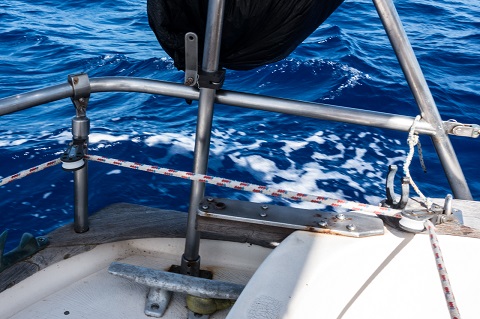 mounted it under the pushpit on the portside mirroring the starboard side. I also lowered the attachment ring from the highest point to eliminate oversteering. Now the lines and the windpilot worked perfectly.
mounted it under the pushpit on the portside mirroring the starboard side. I also lowered the attachment ring from the highest point to eliminate oversteering. Now the lines and the windpilot worked perfectly.
Beruta made  120 nm today.
120 nm today.
In the evening the wind changed to 120° portside and increased to 15 kts. It made possible to use both sails. For a better balance I took two reefs on the main, then raised the jib.
6 August 2016
After midnight the wind became astern. I had to take the jib off. The reefs waited till the morning. No need to rush. I was on schedule.
The day went by without any serious events to mention here. I made  a draw with Fritz on move 55 in the game, which he might win as analysis showed afterwards but I guessed its ILO rating of 2200 was not enough to find the winning move in the end game.
a draw with Fritz on move 55 in the game, which he might win as analysis showed afterwards but I guessed its ILO rating of 2200 was not enough to find the winning move in the end game.
The weather settled. Nice blue skies and moderate following wind and seas. Not too hot in the day and cool at night.
Beruta sailed  110 nm today. 173 nm was left to Aitutaki or two more nights.
110 nm today. 173 nm was left to Aitutaki or two more nights.

7 August 2016
At some point last night the wind died to 5-6 kts, so did the speed. The boat was crawling at 2-3 kts and rolling substantially. I could hardly sleep. This unpleasant motion hinted the necessity to charge the batteries, which I did in the morning from 6 to 10AM. When motoring I prefer to use autopilot, especially in light wind. The water jet from the propeller creates worrying vibration of the hydrovane.
There were lots of boobies around today. I had been trolling for all days but no catch. I would give it another try.
In the daytime the wind blew normally 7-11 kts, broad reach; therefore, Beruta was going under both sails at around 4-5 kts.
These days I was cooking hard making sure I consume all the fresh produce, which would otherwise be taken by biosecurity officer in Cook Islands.
I was also thinking of my next destination. Initially I had wanted to go to Tonga but looked at the stormy winter weather down south, was leaning towards American Samoa that was northwest from Cook Islands. From American Samoa, I could sail further west to Western Samoa, try to beat the SE wind on a way to Tonga or take the easier route to Fiji. I guessed I would choose the direction based on a weather report.
Afternoon the wind moved again astern and the jib went down. The speed was still around 4 kts and to arrive to Aitutaki at the rising tide, even 3 kts would be enough.
Beruta's daily log was  101 nm. 72 nm miles left.
101 nm. 72 nm miles left.
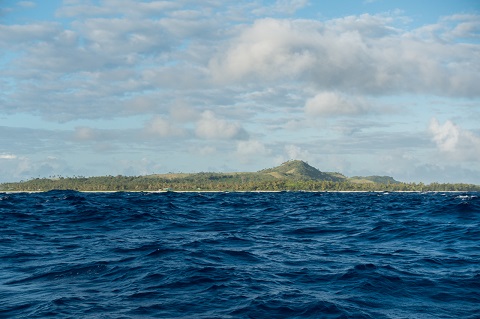
8 August 2016
I spotted Aitutaki before the sunrise. It was surprisingly hilly. I expected it to look more like Tuamotu atolls. On the east side there was no barrier reef, just sandy beaches and no sea breakers. The reef was on all three other sides. The Arutanga passage was actually well marked, contrary to the information on noonsite. There were green and red buoys at the entrance and white poles along the port side of the channel all the way to the anchorage. My Navionics and British charts were also up to date and showed the passage where it was. Noonsite users complained that it was 300 m off. It was indeed very narrow. I would say even 20 meters in most parts, not 30. On my approach to the channel I saw a huge sea turtle crossing the course swimming towards the reef. It made a deep breath and went down when I got closer. There was a dive boat anchored south of the channel. I would guess that it was an excellent diving site.
I was about one hour late for the high water. The ebb started. The depth probably got shallower by no more 0.1 m but the current might have increased. In fact, it was quite strong; perhaps, 3 kts or so. I was running the engine at 3,000 rpm and was making about 3 kts over the ground. The good thing was that the sun rose already high enough and was not directly in front of me, so I could easily see the water colors. The bad thing was that the depth information was wrong everywhere. In the charts it said 1.4 m, meaning that it should have been 2.0 m at high water. On noonsite it said 1.7 m at high water. As the matter of fact it was less than 1.4 m! I bumped two or three times on the sand ripples and then I grounded. I had really hoped to go fast through those sandy bars but no way! I stuck. Now what? The ebb was coming. The next high water would be 12 hours later, at 8PM and by that time Beruta could be blown to the reef. It was there on both sides in just 10 meters!

I had to get out of here. First, I needed to turn the boat around. I was thinking to dinghy the anchor and do it with its help but that would be too slow. The water was going down. The wind already turned the bow half the way but that was it. Now the boat was sitting on the ground perpendicular to the channel. I began reversing and Beruta did go backwards. Good! Now I need to turn the bow. Tiller to the portside and forward! After several attempts, the boat aligned parallel to the channel but was still sitting on the ground. Full throttle, 3,800 rpm, 30 hp! I smelled the burning exhaust fumes. At the stern I saw clouds of sand in the water. And finally, off she moved, wow! Uh... Adrenaline driving passage, no doubt! Good that it was all sand and hopefully no damage was done to the keel.
I got into the sea without further trouble gently bumping off the bottom couple of times again. Anchoring outside of the reef would be rolly and too far from the shore. Also, Noonsite said that holding was marginal here. I had the feeling that entering Aitutaki might fail. Because of a strong permanent outflow, the sand bar got built the same way as in a river mouth. It needed to be dredged from time to time. It seemed that I was not the first one who had problems here. Therefore, I decided to continue the voyage and sail to Palmerston atoll. According to the Noonsite information, although it was not the port of entry, authorities sometimes made exceptions and checked sailboats in and out, especially those who did not make it to Aitutaki. If they refuse the entry, I would go further northwest to American Samoa.
I hoisted the mainsail. The course was 275° M. Downwind sailing on the starboard. The distance was 200 nm, two more nights to go. The wind was astern 10 kts, speed 4.5.
Before the midnight the wind increased to 15 kts gusting to 18. I took reefs.
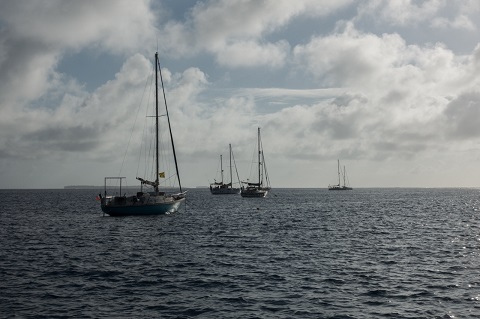
9 August 2016
The moderate wind continued most of the day but died to 5-8 kts after 15PM. It also became more south, so I had to gybe and take the reefs off. The speed was 3 - 3.5 kts, which was enough to reach the island some time tomorrow.
At 4PM local time Beruta was 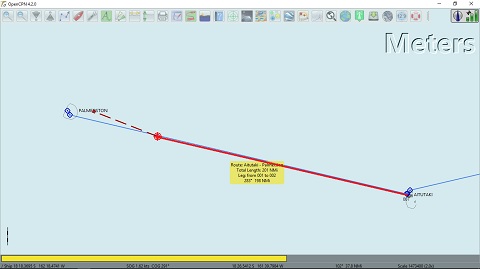 55 nm away from Palmerston.
55 nm away from Palmerston.
10 August 2016
The wind was weak all the night but did get me to 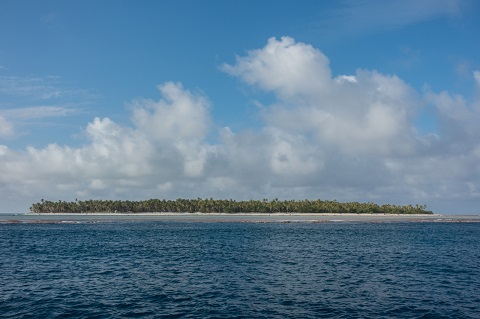 the atoll at dawn. I was contacted by their radio on channel 16 and they okeyed me to clear in. Two nice fellows welcomed Beruta on a powerboat near a mooring buoy. They said that would arrange for the officials to come on board around 11AM.
the atoll at dawn. I was contacted by their radio on channel 16 and they okeyed me to clear in. Two nice fellows welcomed Beruta on a powerboat near a mooring buoy. They said that would arrange for the officials to come on board around 11AM.
While I was waiting for clearance, I saw humpback whale for the first time in Pacific. It was showing his back and making splashes and mist of water at a distance of perhaps 100 meters from the moorings.
I found a wifi hot spot accessible from the moorings for 25 NZD for 500MB for 30 days. In terms of weather it seemed like Friday was a good day to head to American Samoa.
The clearance to Cook Islands in Palmerston cost me 65 USD plus 10 USD for a mooring per day. The mooring fee included transportation to the land through the reef on an aluminum motorboat. My host and a host of some other sailors on moorings was Edward, who offered free welcome lunch on the first day at his house and an island tour after it. He served as a policeman on Palmerston. Good man. He gave me some lemons and I presented him my last bottle of Panamian rum and a pack of Dominican coffee. If you happen to go there, bring him some sigarettes, please.
11 August 2016
In the morning I went snorkelling around the boat checking the keel and the mooring line. The antifouling paint was gone from the bottom of the keel. It actually might have been gone even before the grounding but no other damages had been done. The mooring line had a short chain at the end looped around a dead coral. It seemed like the entire coral on the outside of the reef was dead.
When I was about to get out of water, I heard it, the whale song! Wow, it was loud and amazing. I felt like being in Cousteau movie.
I wanted to make a little documentary about the life on the tiny atoll and spent the morning writing the script and afternoon shooting videos. Now I would need to find time to make a film.
In the evening after swimming with sharks and rays in the lagoon off the Edward's house, where the coral heads appeared to be healthy, Canadian folks from the ketch "Blown Bubble" brought lots of food ashore and all crews from 5 boats on the moorings had a great barbecue with beer and even champagne!
All pictures from the Palmerston atoll are in Google Photos.

